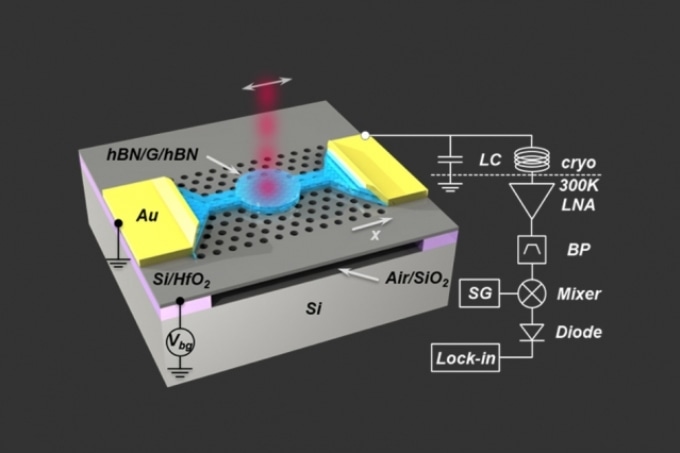Jun 12 2018
 Schematic illustration of the experimental setup. (Image credit: Courtesy of the researchers)
Schematic illustration of the experimental setup. (Image credit: Courtesy of the researchers)
Bolometers are devices used for monitoring electromagnetic radiation by heating an absorbing material. However, the majority of such devices have restricted bandwidth and have to be operated at ultralow temperatures. Now, scientists have invented an ultrafast but highly sensitive substitute with the ability to operate at room temperature.
The outcomes of the study have been reported in the Nature Nanotechnology journal on June 11, 2018. According to the multidisciplinary research group, the study could open the door for innovative types of new heat sensors for buildings, astronomical observatories for long-wavelength emissions, and even innovative types of quantum sensing and information processing devices.
The team includes recent MIT postdoc Dmitri Efetov, Professor Dirk Englund of MIT’s Department of Electrical Engineering and Computer Science, Kin Chung Fong of Raytheon BBN Technologies, and collaborators from MIT and Columbia University.
We believe that our work opens the door to new types of efficient bolometers based on low-dimensional materials.”
Professor Dirk Englund, Senior Author
He stated that for the first time, the new system, which is based on the heating of electrons in a small piece graphene, a two-dimensional form of carbon, combines both high bandwidth and high sensitivity—several orders of magnitude higher when compared to traditional bolometers—in a single device.
“The new device is very sensitive, and at the same time ultrafast,” with the ability to provide readings within a few picoseconds (one-trillionth of 1 second), stated Efetov, who is now a professor at ICFO, the Institute of Photonic Sciences in Barcelona, Spain, and is the lead author of the paper. “This combination of properties is unique,” he stated.
He also stated that the innovative system has the ability to operate at any temperature, in contrast to prevalent devices that have to be cooled to exceptionally low temperatures.
Despite the fact that a majority of the actual applications of the device can still be carried out under such ultracold conditions, for specific applications (for example, thermal sensors for building efficiency), the potential to operate without the need for specialized cooling systems could really be an added advantage.
The new bolometer developed by the researchers, and demonstrated under laboratory conditions, has the ability to measure the total energy of the photons of incoming electromagnetic radiation, irrespective of whether the radiation is in the form of microwaves, radio waves, visible light, or other portions of the spectrum.
The radiation could be from the infrared waves of heat emitted from a badly insulated house, or from faraway galaxies.
The device is completely distinct from conventional bolometers, in which a metal is usually used to absorb the radiation and to measure the ensuing increase in temperature.
Rather, the researchers built an innovative kind of bolometer that is dependent on heating electrons that move in a small piece of graphene, instead of heating a solid metal. The graphene is paired with a device known as a photonic nanocavity, which amplifies the radiation absorption, explained Englund.
Unlike a traditional bolometer, the heated body here is simply the electron gas, which has a very low heat capacity, meaning that even a small energy input due to absorbed photons causes a large temperature swing.”
Professor Dirk Englund, Senior Author
Despite the fact that graphene bolometers were demonstrated even earlier, this study overcomes certain significant difficulties, such as efficient absorption into the graphene with the help of a nanocavity, and the impedance-matched temperature readout.
According to Englund, the innovative technology “opens a new window for bolometers with entirely new functionalities that could radically improve thermal imaging, observational astronomy, quantum information, and quantum sensing, among other applications.”
The new system can be used in astronomical observations for filling in certain left out wavelength bands that cannot be observed by any practical detectors, for instance, the “terahertz gap” of frequencies that are highly challenging to observe with prevalent systems.